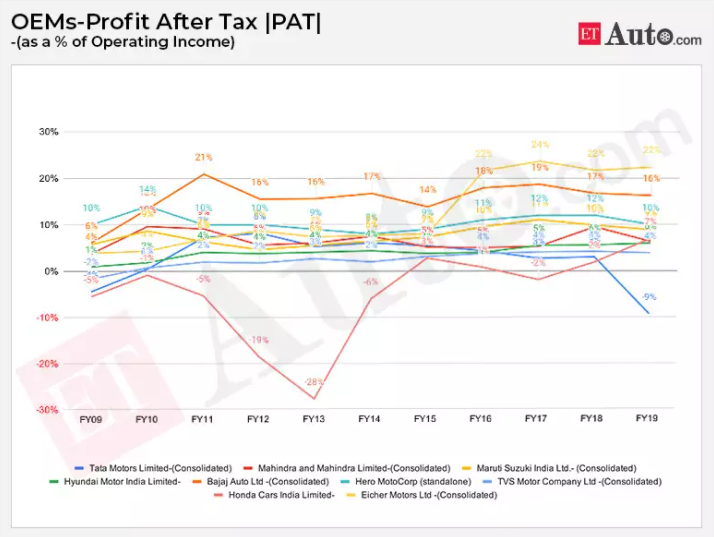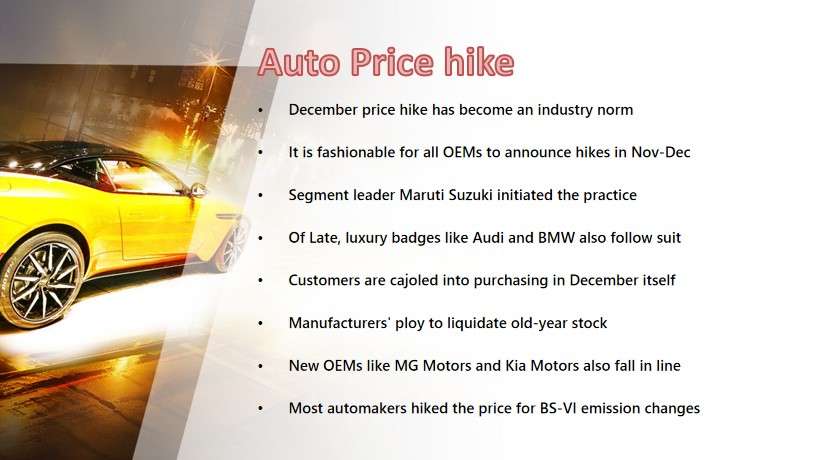Most companies are playing on the ‘Fear Psychosis’ or breeding the greed to

increase retail sales and minimise their carry overstock that loses residual value in the new year by a big margin.
Companies are not feeding their original virtue of providing vehicles to fulfil the country’s mobility and transport needs, but gaining from a weak policy framework that has been exploited for years and continues unabated.
Auto companies are exploiting the customer’s psychology or weakness to avail themselves of heavy year-end discounts, or the tendency to avoid buying pricier New Year models.
Any price-related action affects retail and in fact, drives sales in a sagging month. It also maintains the favourable balance of restricted wholesale dispatches from factories to dealers and allows the manufacturers to dispatch fewer vehicles in a dying year.
This leads to less pressure to retail them and swells most automakers’ profits as they produce fewer units and avoid backlog and stocking of vehicles.
Almost all the OEMs are following the segment leader’s annual price hike trend started in 2005. The others like BMW, Hyundai Motor India, Audi, Mahindra & Mahindra, Tata Motors, and the new entrants MG Motors and Kia also have joined the league.
Some paucity of the iron ore supplies as the raw commodity has led to some increase in price.`
Why do OEMs amplify?
This fear of price increase in January precisely creates a perception to buy vehicles at a lower price or serves as an incentive to purchase vehicles in December to avoid the higher price on the identical product over the next few days.Customers think that they save money by buying a vehicle in December, but the gains are far less than the reduction in the vehicle’s residual value.
For example, if a customer buys a Maruti Baleno Alpha Automatic variant at INR 8.96 lakh (ex-showroom price in Delhi), with possibly a nominal INR 15,000 December discount and if there’s no rebate in 2021, his loss on selling the car will be higher than the gain of a lean discount. If he sells the same car in 2026, even in True Value, the pre-owned vehicle business of Maruti Suzuki, the price for the 2020 model will be a minimum of INR 50,000 less than the price for a 2021 Baleno.
With customers falling into the price trap regularly, this leads to higher demand and increased retail sales in December. It may not be the all-time high but may surpass the sales in the festive month of October, and in March, the high corporate depreciation benefits drive sales.
“December retail beats all the year records. While companies monetise January hikes, the customers gain on the year-end sale at artificial discounting initiated to ‘offload’ all existing stock,” an industry veteran said.
According to analysts, the commodity prices have not shot up as much as the auto companies claim except for some aberrations in steel. Some paucity of the iron ore supplies as the raw commodity has led to some increase in price. This has led to some challenges in procuring steel from the domestic market and has led to increased shipments from overseas. But there has not been any massive demand to necessitate price hike in these pandemic times of lean demand and patchy sales and deliveries.
Commodity prices assessed by ETAuto over the past few months for key raw materials showed a hike in steel, one of the industry’s main item. But other inputs like aluminium, crude that goes into making plastics, rubber and special fibres are still at the moderate levels.
Many manufacturers increased prices when the BS-VI emission norms were implemented in March-April this year. Some manufacturers have shared the reason for the price hike while many others have not released any information about the reason for increasing price earlier this year.
Financial impact
It is not just a reduction in the customers’ gain in buying new cars. It also incurs intrinsic losses to banks and other financial institutions.
It also puts banks and financial institutions that have financed these vehicles at a higher risk as their assets bring less value. Sometimes the residual value may be lower than the money invested on the car. The case is more severe for cabs and taxis that lose much higher value and, thus, proportionate losses.
Besides the financial institutions, the insurance companies also lose business, and their premium on the cars referred to as insured declared value or IDV. For example, a car sold in 2020 will have a lower IDV than the same car sold in January, whereby the insurance company loses on the business earned on insuring the vehicle as well as the premium rendered by customers on their vehicles.
The entire business transaction loses value as companies manipulate to sell more cars in the year-end at a lower value, leading to various stakeholders’ varied financial impact.
Government action
Till date, the government has not been able to align the various facets of the automobile business that have created these fixtures. It has incentivised the auto industry to rationalise prices by streamlining taxes in the past. However, it hasn’t been able to curb the menace of periodic year-end price hikes and other market manipulations.
India is perhaps the only market in the world where IDV, residual value and the calendar value of a single vehicle is totally different. In fact, it varies so much that a single vehicle can have a gap of almost 20%-30% in terms of values depicted in the documents.
Any price-related action affects retail and in fact, drives sales in a sagging month.`
The government needs to move the entire manufacturing cycle to align it with its financial year to minimise the complications and remove the anomalies in the entire system. For instance, across Europe, the OEMs are allowed to manufacture and stamp the next year mark on the vehicles that too are to be retailed in the new year; unlike India where the Central Motor Vehicles Rules does not permit different year stamping and sales.
Industry veterans say that the vehicle identification number or VIN that currently goes with the calendar year has to change and needs to be aligned with the April-March financial year to allow easy and definite calculations of a vehicle’s financial value.
“It will lead to synonymous calculations based on the real value of the car. Once the VIN of vehicles is aligned with the financial year, it will cut the gimmick of the January price hikes that are not based on any logic but driven by the greed of the industry to maximise retails and minimise year-end stock,” said a former MD of an auto major.
India needs to find some prudent ways and practices to determine the car’s real value where the IDV, resale value and the depreciation are aligned together and customers get the absolute value of the price paid on buying the vehicle.
This will not just improve taxation on vehicles on the line of the GST and avoid the principals of the accountancy and finance to play second fiddle to the perceived value of the calendar year of cars.
It will also do away with the practice of customers invoicing their cars in December only to take delivery and register them in January (technically feasible in some places) to hike the residual value in spite of a year earlier manufacturing.
Also, this leads to a situation where no manufacturer brings any new vehicle or launches any car in December when it loses value and customers are averse to buying new products and postpone most of the purchases into next year. Nissan Magnite has changed this with its December launch and 2021 deliveries with the New Year make.

















